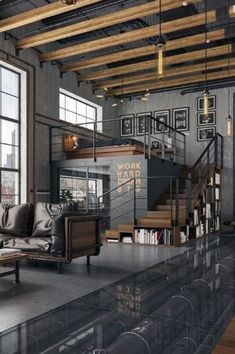The Industrial aesthetic, also known as Industrial design, emerged during the late 19th and early 20th centuries in response to the rapid industrialization and technological advancements of the time. This aesthetic is closely tied to the rise of industrial capitalism and the shift from agrarian economies to manufacturing-based societies. The movement originated in Europe and North America, gaining prominence in the late 19th century, and it was characterized by a focus on functionality, efficiency, and the use of industrial materials.
Origins and Influences:
The Industrial aesthetic was born out of the changing socio-economic landscape of the late 19th century. The Industrial Revolution, which began in the 18th century, led to the mechanization of production processes, mass manufacturing, and the proliferation of new technologies. This shift influenced various aspects of society, including art and design. The Industrial aesthetic drew inspiration from the machine age, celebrating the beauty of industrial materials, and prioritizing function over ornamental design.
Key Players and Timeline:
O ne of the key figures associated with the Industrial aesthetic is the German architect and designer Peter Behrens. Often referred to as the “father of industrial design,” Behrens played a crucial role in establishing the principles of functional design and the integration of art with industry. His work influenced later designers such as Walter Gropius, the founder of the Bauhaus school, which further propagated the ideals of industrial design. The Bauhaus, established in 1919, became a pivotal institution in shaping the Industrial aesthetic.
The Industrial aesthetic also found expression in the work of American architect Louis Sullivan. Sullivan’s famous dictum “form follows function” encapsulates the essence of the Industrial aesthetic, emphasizing the importance of utility in design. Sullivan’s influence extended to the Chicago School of architecture and beyond.
Characteristics and Design Principles:
The Industrial aesthetic is characterized by simplicity, minimalism, and the use of industrial materials such as steel, glass, and concrete. Designers sought to eliminate unnecessary ornamentation and embrace the honest expression of materials and structures. Functionalism was a key principle, with designs serving their intended purpose efficiently. Geometric shapes, clean lines, and the absence of superfluous decoration became defining features of the Industrial aesthetic.
Legacy and Contemporary Influence:
The Industrial aesthetic laid the groundwork for modern design principles and continues to influence contemporary design. The principles of simplicity and functionality have permeated various design disciplines, from product design to architecture. The legacy of the Industrial aesthetic is evident in the sleek and minimalist designs of contemporary technology products, furniture, and urban spaces.
The influence of the Industrial aesthetic is also seen in the rise of modernist architecture and design movements. The streamlined designs of mid-20th-century modernism, characterized by figures like Le Corbusier, were indebted to the principles of the Industrial aesthetic. Additionally, the emphasis on efficiency and functionality has played a significant role in the development of user-centered design in the digital age.






Sources:
– Banham, Reyner. “Theory and Design in the First Machine Age.” MIT Press, 1980.
– Pevsner, Nikolaus. “Pioneers of Modern Design: From William Morris to Walter Gropius.” Penguin Books, 1936.
– Woodham, Jonathan M. “Twentieth-Century Design.” Oxford University Press, 1997.

5 Comments. Leave new
[…] luxurious statement piece, perfect for both classic and contemporary interiors. For a modern and industrial aesthetic, applying a concrete overlay introduces a sleek yet sophisticated vibe, blending durability with […]
[…] businesses seeking a distinctive edge, the industrial aesthetic also serves as a unique branding tool, reflecting creativity and forward-thinking ideals. Yet, this […]
[…] industrial roots have inspired many homeowners to embrace an industrial aesthetic in their home renovations. Exposed brick, steel beams, and concrete floors add raw character and […]
This is a great, thorough analysis on the industrial aesthetic. Specifically, the amount of context and history that you give for this genre is excellent and really sets the scene for the industrial aesthetic. In addition, your definition of the industrial aesthetic and its characteristics is very well done and paints a perfect picture of what this aesthetic represents. Please elaborate on your choice to put all of your pictures at the end of the post, as opposed to using them to break up the text.
Adlai, I think is a really cool aesthetic as well. I think it is interesting that you stated the industrial aesthetic prioritizes function over ornamentation. I think this is a good way of looking over the industrial aesthetic and other simplistic aesthetics. Its almost as if the “ornamentation” is the machine parts or other industrial materials. It takes a different stance on art as a more rustic and dull principle rather than flashy and extravagant like most art is. Good job on this post!